二次谐波具体公式1.3502596
第4讲 二次谐波产生、相位匹配考虑

' 1 2 i kn P w 2 , z e z 2
E 1 z E 1 z i 2k1z 2 1 0 w 2 ;w1 , w1 e 2 2
简并度
辐射出二次谐波的电极化强度振幅:
2 1 2 P w2 , z 0 w2 ;w1 , w1 E 1 z E 1 z 2
2 2
2
d E2 z dz
w1deff
n2c
E1 z
2
w1deff 2 2 E 0 E z 1 2
n2c
利用积分公式:
dv 1 1 v a2 v 2 a tanh a
w1d eff E2 z E1 0 tanh E1 0 z n c 2 w1d eff E1 z E1 0 sech E1 0 z n2 c
(单色、均匀平面波)
基频波与介质相互作用产生的极化场:
' 1 2 ikn P ( t ) P wn , z e z e iwnt c .c . 2 2 1 1 ik1z iw1t 0 E 1 z e e c .c . E 1 z e ik1z e iw1t c .c . 2 2 激励出二次谐波的极化强度P(2w1)在频率内(不含时间项)的
考虑到电场强度和非线性极化强度是实数,应在光电场复 振幅和非线性极化场复振幅前乘以系数1/2,这样计算和实验 结果才能相一致.
1 ikn z iw n t E n ( z , t ) E n ( z )e e c .c . 2 NL NL ' 1 z iw n t P n ( z , t ) P n ( z )e ikn e c .c . 2
二次谐波的概念
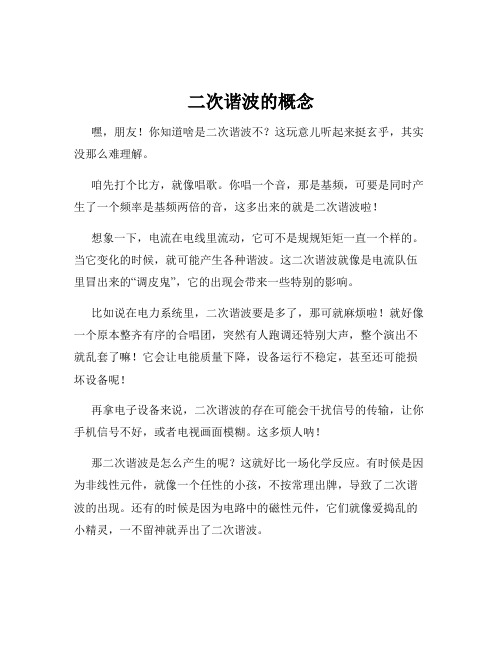
二次谐波的概念
嘿,朋友!你知道啥是二次谐波不?这玩意儿听起来挺玄乎,其实没那么难理解。
咱先打个比方,就像唱歌。
你唱一个音,那是基频,可要是同时产生了一个频率是基频两倍的音,这多出来的就是二次谐波啦!
想象一下,电流在电线里流动,它可不是规规矩矩一直一个样的。
当它变化的时候,就可能产生各种谐波。
这二次谐波就像是电流队伍里冒出来的“调皮鬼”,它的出现会带来一些特别的影响。
比如说在电力系统里,二次谐波要是多了,那可就麻烦啦!就好像一个原本整齐有序的合唱团,突然有人跑调还特别大声,整个演出不就乱套了嘛!它会让电能质量下降,设备运行不稳定,甚至还可能损坏设备呢!
再拿电子设备来说,二次谐波的存在可能会干扰信号的传输,让你手机信号不好,或者电视画面模糊。
这多烦人呐!
那二次谐波是怎么产生的呢?这就好比一场化学反应。
有时候是因为非线性元件,就像一个任性的小孩,不按常理出牌,导致了二次谐波的出现。
还有的时候是因为电路中的磁性元件,它们就像爱捣乱的小精灵,一不留神就弄出了二次谐波。
对于工程师们来说,了解二次谐波那可是相当重要。
得像侦探一样,敏锐地发现它,准确地测量它,然后想办法把它的影响降到最低。
不然,设计出来的电路、系统可能就会出大问题。
总之,二次谐波虽然神秘,但只要我们用心去了解它,掌握它的规律,就能让它乖乖听话,为我们服务,而不是捣乱。
你说是不是这个
理儿?二次谐波,咱可不能小瞧了它,得好好研究,好好对付!。
倍频效应二次谐波精编版

倍频效应二次谐波集团企业公司编码:(LL3698-KKI1269-TM2483-LUI12689-ITT289-倍频现象的理论解释线性光学效应的特点:出射光强与入射光强成正比;不同频率的光波之间没有相互作用,没有相互作用包括不能交换能量;效应来源于介质中与作用光场成正比的线性极化。
非线性光学效应的特点:出射光强不与入射光强成正比(例如成平方或者三次方的关系);不同频率光波之间存在相互作用,可以交换能量;效应来源于介质中与作用光场不成正比的非线性极化。
倍频效应是非线性的光学效应,当介质在光波电场的作用下时,会产生极化。
设P是光场E在介质中产生的极化强度。
对于线性光学过程:P=ε0χE对于非线性光学过程:P可以展开为E的幂级数:ε=ε0χ(1)E+ε0χ(2)E2+ε0χ(3)E3+...ε0χ(ε)Eε+…其中:ε(1)=ε0χ(1)E,ε(2)=ε0χ(2)ε2,ε(3)=ε0χ(3)ε3,…,ε(ε)=ε0χ(ε)εε分别为线性以及2,3,…,n阶非线性极化强度。
χ(ε)为n阶极化率。
正是这些非线性极化项的出现,导致了各种非线性光学效应的产生。
而倍频效应,就是由其中的二阶极化强度ε(2)所导致产生的:ε−设光场是频率为ε、波矢为ε⃗⃗⃗⃗ 的单色波,即:ε=12εε−εε+c.c.ε0ε(2)ε2−则ε(2)=ε0χ(2)ε2中将出现项:142εε−2εε+c.c.该极化项的出现,可以看作介质中存在频率为2ε的振荡电偶极矩,它的辐射便可能产生频率为2ε的倍频光。
介质产生非线性极化:从微观上看,非线性是由原子、分子非谐性所造成的。
物质受强光作用后,电子发生位移x,具有位能V(x),对于无对称中心晶体,与电子位移+x和-x相对应的位能并不相等,即:V(+X)≠V(-x),因而位能函数V(x)应该包含奇次项:ε(ε)=12εε02ε2+13εεε3+⋯相应的,电子与核之间的恢复力为:ε=−ε(ε)ε=−(εεε2ε+εεε2+⋯)当D>0时,正位移(ε>0)引起的恢复力大于负位移(ε<0)引起的恢复力。
(推荐)二次谐波的产生及其解
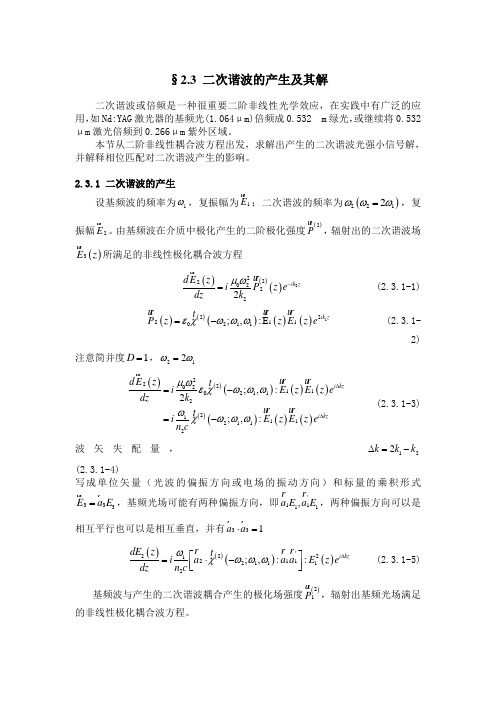
§2.3 二次谐波的产生及其解二次谐波或倍频是一种很重要二阶非线性光学效应,在实践中有广泛的应用,如Nd:YAG 激光器的基频光(1.064μm)倍频成0.532m 绿光,或继续将0.532μm 激光倍频到0.266μm 紫外区域。
本节从二阶非线性耦合波方程出发,求解出产生的二次谐波光强小信号解,并解释相位匹配对二次谐波产生的影响。
2.3.1 二次谐波的产生设基频波的频率为1ω,复振幅为1E u r;二次谐波的频率为()2212ωωω=,复振幅2E u r 。
由基频波在介质中极化产生的二阶极化强度()2P u r ,辐射出的二次谐波场()3E z u r所满足的非线性极化耦合波方程()()()222202222ik z d E z i P z e dz k μω-= u ru r (2.3.1-1) ()()()()()1222110211;,ik z P z z E z e εχωωω=-:E u r u r u r t (2.3.1-2)注意简并度1D =,212ωω=()()()()()()()()()22202110211221112112;,2;,i kzi kzd E z i E z E ze dz k i E z E z e n cμωεχωωωωχωωω∆∆=-:=-:u ru r u r t u r u r t (2.3.1-3)波矢失配量,122k k k ∆=-(2.3.1-4)写成单位矢量(光波的偏振方向或电场的振动方向)和标量的乘积形式333E a E =u r r,基频光场可能有两种偏振方向,即'1111,a E a E r r ,两种偏振方向可以是相互平行也可以是相互垂直,并有331a a ⋅=r r()()()()'222121121112;,i kz dE z i a a a E z e dz n c ωχωωω∆⎡⎤=⋅-::⎢⎥⎣⎦r r r t (2.3.1-5)基频波与产生的二次谐波耦合产生的极化场强度()21P u r ,辐射出基频光场满足的非线性极化耦合波方程。
电压偕波,的计算公式
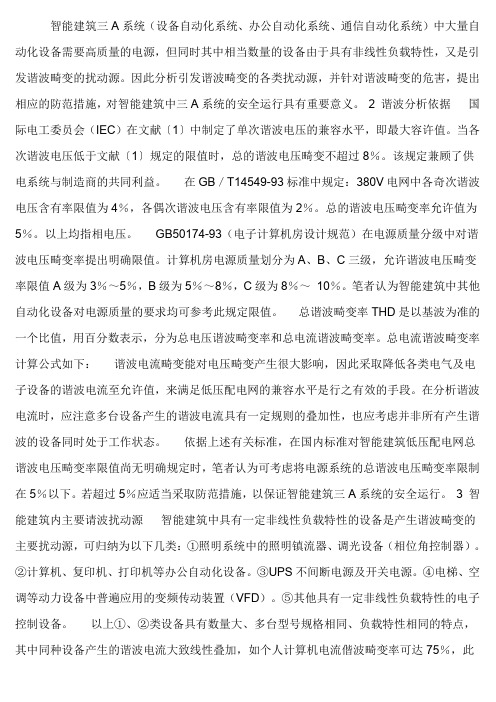
智能建筑三A系统(设备自动化系统、办公自动化系统、通信自动化系统)中大量自动化设备需要高质量的电源,但同时其中相当数量的设备由于具有非线性负载特性,又是引发谐波畸变的扰动源。
因此分析引发谐波畸变的各类扰动源,并针对谐波畸变的危害,提出相应的防范措施,对智能建筑中三A系统的安全运行具有重要意义。
2 谐波分析依据国际电工委员会(IEC)在文献〔1〕中制定了单次谐波电压的兼容水平,即最大容许值。
当各次谐波电压低于文献〔1〕规定的限值时,总的谐波电压畸变不超过8%。
该规定兼顾了供电系统与制造商的共同利益。
在GB/T14549-93标准中规定:380V电网中各奇次谐波电压含有率限值为4%,各偶次谐波电压含有率限值为2%。
总的谐波电压畸变率允许值为5%。
以上均指相电压。
GB50174-93(电子计算机房设计规范)在电源质量分级中对谐波电压畸变率提出明确限值。
计算机房电源质量划分为A、B、C三级,允许谐波电压畸变率限值A级为3%~5%,B级为5%~8%,C级为8%~10%。
笔者认为智能建筑中其他自动化设备对电源质量的要求均可参考此规定限值。
总谐波畸变率THD是以基波为准的一个比值,用百分数表示,分为总电压谐波畸变率和总电流谐波畸变率。
总电流谐波畸变率计算公式如下:谐波电流畸变能对电压畸变产生很大影响,因此采取降低各类电气及电子设备的谐波电流至允许值,来满足低压配电网的兼容水平是行之有效的手段。
在分析谐波电流时,应注意多台设备产生的谐波电流具有一定规则的叠加性,也应考虑并非所有产生谐波的设备同时处于工作状态。
依据上述有关标准,在国内标准对智能建筑低压配电网总谐波电压畸变率限值尚无明确规定时,笔者认为可考虑将电源系统的总谐波电压畸变率限制在5%以下。
若超过5%应适当采取防范措施,以保证智能建筑三A系统的安全运行。
3 智能建筑内主要请波扰动源智能建筑中具有一定非线性负载特性的设备是产生谐波畸变的主要扰动源,可归纳为以下几类:①照明系统中的照明镇流器、调光设备(相位角控制器)。
谐波
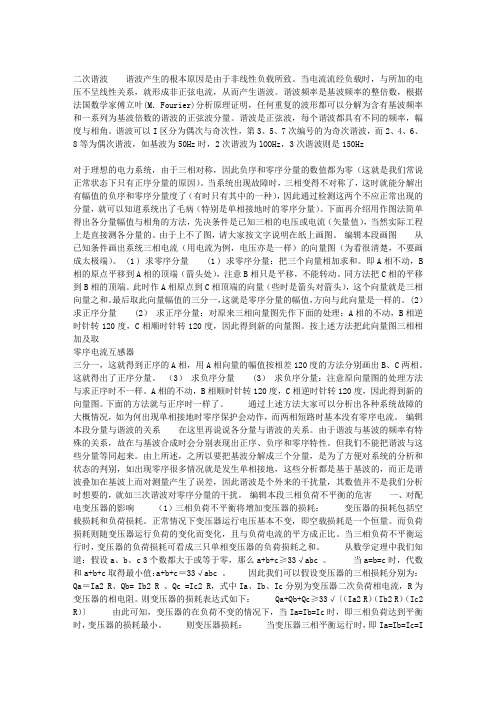
二次谐波谐波产生的根本原因是由于非线性负载所致。
当电流流经负载时,与所加的电压不呈线性关系,就形成非正弦电流,从而产生谐波。
谐波频率是基波频率的整倍数,根据法国数学家傅立叶(M.Fourier)分析原理证明,任何重复的波形都可以分解为含有基波频率和一系列为基波倍数的谐波的正弦波分量。
谐波是正弦波,每个谐波都具有不同的频率,幅度与相角。
谐波可以I区分为偶次与奇次性,第3、5、7次编号的为奇次谐波,而2、4、6、8等为偶次谐波,如基波为50Hz时,2次谐波为lOOHz,3次谐波则是150Hz对于理想的电力系统,由于三相对称,因此负序和零序分量的数值都为零(这就是我们常说正常状态下只有正序分量的原因)。
当系统出现故障时,三相变得不对称了,这时就能分解出有幅值的负序和零序分量度了(有时只有其中的一种),因此通过检测这两个不应正常出现的分量,就可以知道系统出了毛病(特别是单相接地时的零序分量)。
下面再介绍用作图法简单得出各分量幅值与相角的方法,先决条件是已知三相的电压或电流(矢量值),当然实际工程上是直接测各分量的。
由于上不了图,请大家按文字说明在纸上画图。
编辑本段画图从已知条件画出系统三相电流(用电流为例,电压亦是一样)的向量图(为看很清楚,不要画成太极端)。
(1 ) 求零序分量(1 ) 求零序分量:把三个向量相加求和。
即A相不动,B 相的原点平移到A相的顶端(箭头处),注意B相只是平移,不能转动。
同方法把C相的平移到B相的顶端。
此时作A相原点到C相顶端的向量(些时是箭头对箭头),这个向量就是三相向量之和。
最后取此向量幅值的三分一,这就是零序分量的幅值,方向与此向量是一样的。
(2)求正序分量(2)求正序分量:对原来三相向量图先作下面的处理:A相的不动,B相逆时针转120度,C相顺时针转120度,因此得到新的向量图。
按上述方法把此向量图三相相加及取零序电流互感器三分一,这就得到正序的A相,用A相向量的幅值按相差120度的方法分别画出B、C两相。
什么是谐波?电力系统谐波怎么产生的?老司机给你科普一下!

什么是谐波?电力系统谐波怎么产生的?老司机给你科普一下!(1)谐波的含义在振动学里认为一个振动产生的波里具有一定频率的振幅最大的正弦波叫基波。
其他高于基波频率的小波就叫作谐波。
电力系统对谐波的定义:对周期性非正弦电量(电压或电流)进行傅立叶级数分解,除了得到与电网基波频率相同的分量,还得到一系列大于电网基波频率的分量,这部分电量称为谐波。
(基波及其表达式)(基波及2.3.4次谐波)(掺入2.3.4次谐波后的复合波)(2)谐波的产生电力系统是由发电、变电、输配电和用电这四个环节所组成的整体,每个环节均有可能产生谐波。
发电环节:略...变电环节:略...输配电环节:略...用电环节:用电系统中谐波主要是由非线性负载引起,由于正弦电压加压于非线性负载,基波电流发生畸变产生谐波。
主要非线性负载有UPS、开关电源、整流器、变频器、逆变器等。
三次谐波公式:复合波公式:(3)非线性设备含义简言之,设备中产生的电流波形是断续的或突变的,它不是一个可采用线性法则进行运算的连续函数,一般要采用傅里叶级数来描述它。
例如:上图为三相整流回路,整流后的电流波形为阶梯方波,右图是按傅里叶级数展开后的频谱,可以看出五次和七次谐波比例很高。
又如:上图为单相整流回路,整流后的电流波形为断续波形,右图是按傅里叶级数展开后的频谱,其中三次谐波比例很高。
(4)三次谐波电流的特殊性三次谐波电流主要是由单相非线性负载(如荧光灯,节能灯及镇流器等)产生的。
因其频率的特殊性,三次谐波在电网中性线上产生的后果尤为严重。
在三相电网中,基波各相的相位差为120°;而三次谐波相位差为360°。
由下图可见,各相线内的三次谐波电流在中性线上汇集时,其瞬时值是直接同相相加的,故中性线上的三次谐波电流一般为约为3倍的相线上的三次谐波电流,甚至会大于相线上的基波电流。
来源:继保小知识。
总谐波电流有效值计算公式

总谐波电流有效值计算公式总谐波电流有效值计算公式,这听起来好像有点复杂,但其实也没那么难理解。
咱们先来说说啥是谐波电流。
想象一下,电流就像一条流淌的小河,本来应该是平稳顺畅的,但有时候会出现一些“小波浪”,这些“小波浪”就是谐波电流。
那怎么计算总谐波电流的有效值呢?这就得用到专门的公式啦。
总谐波电流有效值的计算公式是:$I_{THD}=\sqrt{\sum_{n=2}^{\infty}I_{n}^{2}}$ ,这里的$I_{n}$表示第 n 次谐波电流的有效值。
我给您举个例子啊。
比如说在一个电路中,我们测得了 2 次谐波电流的有效值是 5A,3 次谐波电流的有效值是 3A,4 次谐波电流的有效值是 2A。
那按照公式来算,总谐波电流有效值就是:$\sqrt{5^{2} +3^{2} + 2^{2}} = \sqrt{25 + 9 + 4} = \sqrt{38}$ ,大概是 6.16A 。
我之前在一个工厂里做电路检测的时候,就碰到过谐波电流的问题。
那时候厂里的设备老是出故障,运转不太正常。
我们一开始都摸不着头脑,找了好久的原因。
后来经过仔细的检测和分析,发现就是谐波电流在捣乱。
当时为了算出总谐波电流有效值,可费了不少功夫呢。
拿着仪器测各种数据,在本子上密密麻麻地记录,然后再对照着公式一点点计算。
那场景,就跟打仗似的,紧张又刺激。
在实际应用中,准确计算总谐波电流有效值非常重要。
它能帮助我们判断电力系统的质量,及时发现问题,采取措施来减少谐波的影响,保障设备的正常运行。
比如说,通过安装滤波器,就可以有效地降低谐波电流,让电流这条“小河”重新变得平稳顺畅。
总之,虽然总谐波电流有效值计算公式看起来有点复杂,但只要我们掌握了方法,多结合实际情况去运用,就能轻松应对谐波电流带来的各种问题啦。
希望您也能顺利搞定这个知识点!。
高二物理竞赛课件二次谐波发生器
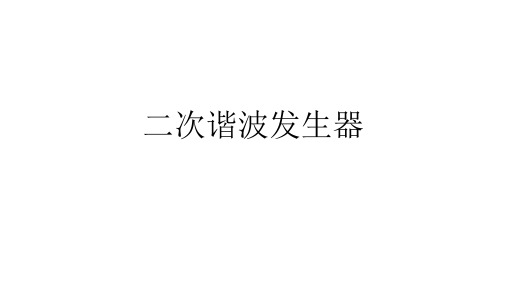
若引力非谐项为x2,则阻尼谐振子的运动 方程为:
mx 1x fx x 2 eE (10-22)
对于交变电场E=E0exp(2it),求解 x=x1exp(it)+x2exp(2it),并且x2<<1形 式的解,可得到:
5
x2
l (02
2
(e / m)3 E02 i1 / m)(02 42
二次谐波发生器
二次谐波发生器
大多数激光器的工作频率在红光到红外段 (如He-Ne激光器为11526Å;钕玻璃激光器 10600Å;红宝石激光器6973Å)。为了发射 可见光,需要产生谐波,其中以二次谐波 的能量最高。二次谐波的产生与非线性介 电效应相联系,但非线性介电效应与铁电 性并无必然联系。非线性是由于键力缺少 简谐性导致的。
9
对于中心对称晶体,电场符号的改变不影响 极化强度的大小,因此1=0。对二次谐波, P与E之间的关系为:
Pi (2) i1Ex2 i2 Ey2 i3 Ez2 (10-27) i4 Ey Ez i5 Ez Ex i6 Ex Ey
10
对于沿x方向传播的交变电场 E()=E0sin(t-kx),由频率为2的场所产 生的极化强度可写为:
2
因此,在电场的E[110]和E[1 10 ]两个分量之 间 出 现 相 位 滞 后 。 对 KDP 晶 体 , 109cm/V , 。 当 长 5cm 的 KDP 棒 , 施 加 电 场 是 2103V/cm,=7000Å,相位滞后为弧度。然 后可以对投射光进行分析和探测。
3
因此,如果在没有电场时没有光线通过探 测器,在有电场时,可能有光线通过。在 这一方面,可作为光断续器。如果施加交 变电场,由外加电场的频率可实现振幅调 制。对于KDP、石英和钛酸钡晶体,工作频 率大约在1010Hz。
谐波的定义及测试方法

供电系统谐波的定义是对周期性非正弦电量进行傅立叶级数分解,除了得到与电网基波频率相同的分量,还得到一系列大于电网基波频率的分量,这部分电量称为谐波。
谐波频率与基波频率的比值(n=fn/f1) 称为谐波次数。
电网中有时也存在非整数倍谐波,称为非谐波(Non-harmonics )或分数谐波。
谐波实际上是一种 干扰量,使电网受到“污染”。
目前公司常用测试输入电流谐波的仪器有TEK 系列示波器(可采用WAVESTAR 软件进行谐波分析),测试输出电压谐波的仪器有GW GAD-201G (失真仪)和TEK 系列示波器(可采用WAVESTAR 软件进行谐波分析)。
使用下面的方法计算信号的THD : () ++++++=272625242322211A A A A A A A THD 其中A 1是幅频特性中基波的幅值,而A 2 、A 3、A 4、A 5、……分别是2、3、4、5、……次谐波的幅值。
选取不同数量的谐波分量,可以计算出对应的THD 值。
采用WAVESTAR 软件进行分析可以得到完整谐波分析数据,下图为分析得出的柱型图,从图中可以针对各次谐波异常的状况采取相应的对策进行改善: Harmonic magnitude as a % of the fundamental amplitude0.0%0.7%1.5%2.2%3.0%3.7%4.4%5.2%5.9%6.6%7.4%8.1%Voltage:Current: Ch 1# Harmonics: 20Type: Current Magnitude波峰因数定义为交流信号峰值与有效值之比(峰均比),典型的波峰因数是: 正弦波:1.414;方波: 1;25%的占空比的脉冲:2 。
波峰因数(CREST FACTOR )的概念在UPS 行业是用来衡量UPS 带非线性负载的能力,对线性负载(R LOAD )而言,正弦波电流峰值Ipeak 与均方根值Irms 之比为1.414:1;在非线性负载(RCD LOAD )时,波峰因数则被认定为:在相同的有功功率条件下,非线性负载的电流峰值与非线性负载电流均方根值之比。
倍频效应(二次谐波)
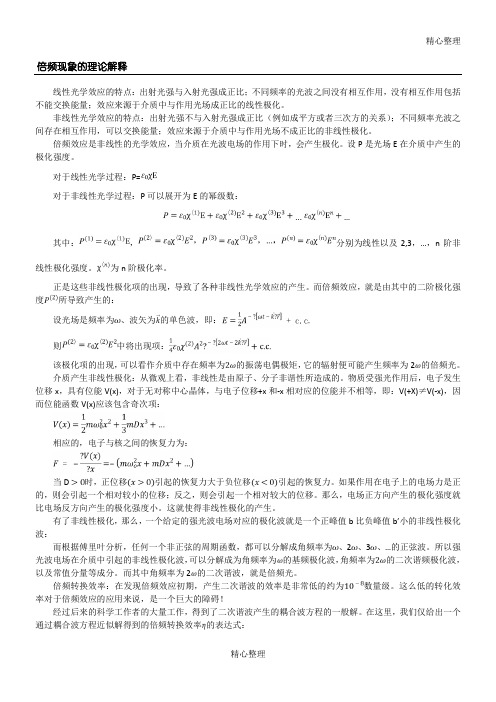
精心整理精心整理倍频现象的理论解释线性光学效应的特点:出射光强与入射光强成正比;不同频率的光波之间没有相互作用,没有相互作用包括不能交换能量;效应来源于介质中与作用光场成正比的线性极化。
非线性光学效应的特点:出射光强不与入射光强成正比(例如成平方或者三次方的关系);不同频率光波之间存在相互作用,可以交换能量;效应来源于介质中与作用光场不成正比的非线性极化。
倍频效应是非线性的光学效应,当介质在光波电场的作用下时,会产生极化。
设P 是光场E 在介质中产生的极化强度。
对于线性光学过程:P=对于非线性光学过程:P 可以展开为E 的幂级数:其中:,…,n 阶非线性极化强度。
为n 阶极化率。
正是这些非线性极化项的出现,度所导致产生的: 设光场是频率为、波矢为的单色波,即:则中将出现项: 该极化项的出现,可以看作介质中存在频率为的振荡电偶极矩,的倍频光。
介质产生非线性极化:从微观上看,非线性是由原子、分子非谐性所造成的。
物质受强光作用后,电子发生位移x ,具有位能V(x)+x 和-x 相对应的位能并不相等,即:V(+X)≠V(-x),因而位能函数V(x)应该包含奇次项:当D 时,正位移引起的恢复力大于负位移引起的恢复力。
如果作用在电子上的电场力是正的,则会引起一个相对较小的位移;反之,则会引起一个相对较大的位移。
那么,电场正方向产生的极化强度就比电场反方向产生的极化强度小。
这就使得非线性极化的产生。
有了非线性极化,那么,一个给定的强光波电场对应的极化波就是一个正峰值b 比负峰值b ’小的非线性极化波:而根据傅里叶分析,任何一个非正弦的周期函数,都可以分解成角频率为、2、3、…的正弦波。
所以强光波电场在介质中引起的非线性极化波,可以分解成为角频率为的基频极化波,角频率为的二次谐频极化波,以及常值分量等成分。
而其中角频率为2的二次谐波,就是倍频光。
倍频转换效率:在发现倍频效应初期,产生二次谐波的效率是非常低的约为数量级。
什么是二次谐波三次谐波高次谐波
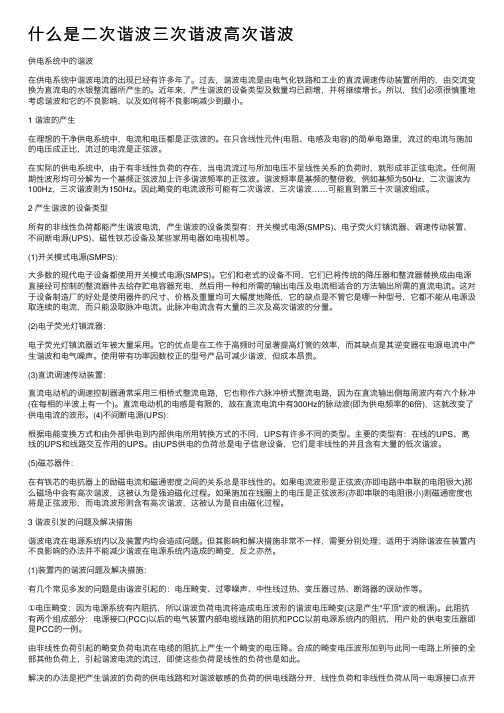
什么是⼆次谐波三次谐波⾼次谐波供电系统中的谐波在供电系统中谐波电流的出现已经有许多年了。
过去,谐波电流是由电⽓化铁路和⼯业的直流调速传动装置所⽤的,由交流变换为直流电的⽔银整流器所产⽣的。
近年来,产⽣谐波的设备类型及数量均已剧增,并将继续增长。
所以,我们必须很慎重地考虑谐波和它的不良影响,以及如何将不良影响减少到最⼩。
1 谐波的产⽣在理想的⼲净供电系统中,电流和电压都是正弦波的。
在只含线性元件(电阻、电感及电容)的简单电路⾥,流过的电流与施加的电压成正⽐,流过的电流是正弦波。
在实际的供电系统中,由于有⾮线性负荷的存在,当电流流过与所加电压不呈线性关系的负荷时,就形成⾮正弦电流。
任何周期性波形均可分解为⼀个基频正弦波加上许多谐波频率的正弦波。
谐波频率是基频的整倍数,例如基频为50Hz,⼆次谐波为100Hz,三次谐波则为150Hz。
因此畸变的电流波形可能有⼆次谐波、三次谐波……可能直到第三⼗次谐波组成。
2 产⽣谐波的设备类型所有的⾮线性负荷都能产⽣谐波电流,产⽣谐波的设备类型有:开关模式电源(SMPS)、电⼦荧⽕灯镇流器、调速传动装置、不间断电源(UPS)、磁性铁芯设备及某些家⽤电器如电视机等。
(1)开关模式电源(SMPS):⼤多数的现代电⼦设备都使⽤开关模式电源(SMPS)。
它们和⽼式的设备不同,它们已将传统的降压器和整流器替换成由电源直接经可控制的整流器件去给存贮电容器充电,然后⽤⼀种和所需的输出电压及电流相适合的⽅法输出所需的直流电流。
这对于设备制造⼚的好处是使⽤器件的尺⼨、价格及重量均可⼤幅度地降低,它的缺点是不管它是哪⼀种型号,它都不能从电源汲取连续的电流,⽽只能汲取脉冲电流。
此脉冲电流含有⼤量的三次及⾼次谐波的分量。
(2)电⼦荧光灯镇流器:电⼦荧光灯镇流器近年被⼤量采⽤。
它的优点是在⼯作于⾼频时可显著提⾼灯管的效率,⽽其缺点是其逆变器在电源电流中产⽣谐波和电⽓噪声。
使⽤带有功率因数校正的型号产品可减少谐波,但成本昂贵。
谐波
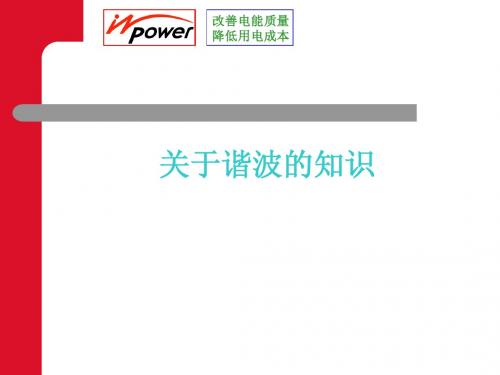
关于谐波的知识
改善电能质量 降低用电成本
什么是谐波 ?
畸变的正弦波产生谐波 畸变的电流波产生电流谐波. 畸变的电压波产生电压谐波. 傅立叶变换可以将畸变波分解为基波和N次谐波列的成分. Nth 次谐波 对应 n.Fs频率. 由于半波对称,通常普遍存在的是奇次谐波.
改善电能质量 降低用电成本
谐波滤波器的特性
容性
Impedance
感性
fR= 谐振频率 f < fR - 容性 f > fR - 感性
谐波滤波器基于fR 怎样接近谐波频率 来分类
fR
Frequency
改善电能质量 降低用电成本
谐波滤波器的分类
非调谐(Detuned)或谐波抑制滤波器
谐振频率
fR< 最低主谐波频率的90%.
选择谐波滤波器的标准
调谐(tuned)滤波器 功率因数调整和减低 THD(V)极为重要.
If 采用普通电容器则吸收电流 > 它的额定电流的130%. 安装调谐滤波器需要进行谐波研究(规划). 每一个安装位置(谐波点)都要进行特定设计. 非常大的, 因为它传送大量的谐波电流 ,因而昂贵.
改善电能质量 降低用电成本
非调谐(detuned)滤波器的设计特点
非调谐滤波器由特定设计的电容器和电抗器的匹配对 组成. 非调谐滤波器被设计成在线路额定电压下,供应额定 无功. 电抗器和电容器组合套件按照额定调谐参数进行设计. 在440V电压,采用7%额定调谐参数的标准非调谐滤 波器有15, 20, 25, 30 & 50 kVAr的可选容量系列.
M
等效负载阻抗ZL”
机械振动谐波频率计算公式

机械振动谐波频率计算公式引言。
机械振动是指物体在受到外力作用下产生的周期性运动。
在机械工程中,振动是一个非常重要的现象,它涉及到机械系统的稳定性、寿命和性能等方面。
而谐波频率则是振动中的一个重要参数,它可以帮助我们了解振动系统的特性和行为。
本文将介绍机械振动的谐波频率计算公式,帮助读者更好地理解和应用振动理论。
1. 谐波频率的定义。
谐波频率是指在振动系统中,当外力作用频率为系统固有频率的整数倍时,系统会出现共振现象,这些整数倍的频率就是谐波频率。
谐波频率对于振动系统的稳定性和响应特性有着重要的影响,因此对谐波频率的计算和分析是非常重要的。
2. 谐波频率计算公式。
在机械振动中,谐波频率的计算可以通过以下公式进行:f_n = n f。
其中,f_n为第n个谐波频率,n为整数,f为系统的固有频率。
这个公式表明,谐波频率是系统固有频率的整数倍,当外力作用频率为系统固有频率的整数倍时,系统会出现共振现象。
3. 谐波频率的影响因素。
谐波频率的计算是基于系统的固有频率,而系统的固有频率又受到多种因素的影响。
以下是影响系统固有频率的主要因素:(1)系统的质量,系统的质量越大,固有频率越小;(2)系统的刚度,系统的刚度越大,固有频率越大;(3)系统的阻尼,系统的阻尼越大,固有频率越小。
这些因素都会对系统的固有频率产生影响,进而影响谐波频率的计算和分析。
4. 谐波频率的应用。
谐波频率的计算和分析对于机械振动系统的设计和优化具有重要意义。
通过对谐波频率的计算,可以帮助工程师更好地了解系统的振动特性,从而设计出更稳定、更可靠的机械系统。
此外,在振动控制和抑制方面,谐波频率的计算也可以帮助工程师选择合适的控制手段,降低系统的振动响应。
结论。
机械振动的谐波频率是振动系统的重要参数,它可以帮助我们了解系统的振动特性和行为。
通过谐波频率的计算公式,可以更好地分析和优化机械振动系统,提高系统的稳定性和性能。
因此,对谐波频率的计算和分析具有重要的工程意义,对于机械工程师来说是一个重要的研究课题。
比率制动系数 二次谐波制动系数
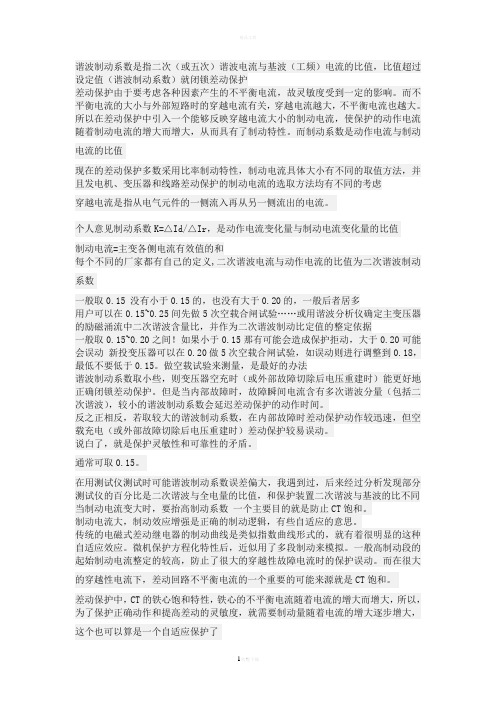
谐波制动系数是指二次(或五次)谐波电流与基波(工频)电流的比值,比值超过设定值(谐波制动系数)就闭锁差动保护差动保护由于要考虑各种因素产生的不平衡电流,故灵敏度受到一定的影响。
而不平衡电流的大小与外部短路时的穿越电流有关,穿越电流越大,不平衡电流也越大。
所以在差动保护中引入一个能够反映穿越电流大小的制动电流,使保护的动作电流随着制动电流的增大而增大,从而具有了制动特性。
而制动系数是动作电流与制动电流的比值现在的差动保护多数采用比率制动特性,制动电流具体大小有不同的取值方法,并且发电机、变压器和线路差动保护的制动电流的选取方法均有不同的考虑穿越电流是指从电气元件的一侧流入再从另一侧流出的电流。
个人意见制动系数K=△Id/△Ir,是动作电流变化量与制动电流变化量的比值制动电流=主变各侧电流有效值的和每个不同的厂家都有自己的定义,二次谐波电流与动作电流的比值为二次谐波制动系数一般取0.15 没有小于0.15的,也没有大于0.20的,一般后者居多用户可以在0.15~0.25间先做5次空载合闸试验……或用谐波分析仪确定主变压器的励磁涌流中二次谐波含量比,并作为二次谐波制动比定值的整定依据一般取0.15~0.20之间!如果小于0.15那有可能会造成保护拒动,大于0.20可能会误动新投变压器可以在0.20做5次空载合闸试验,如误动则进行调整到0.18,最低不要低于0.15。
做空载试验来测量,是最好的办法谐波制动系数取小些,则变压器空充时(或外部故障切除后电压重建时)能更好地正确闭锁差动保护。
但是当内部故障时,故障瞬间电流含有多次谐波分量(包括二次谐波),较小的谐波制动系数会延迟差动保护的动作时间。
反之正相反,若取较大的谐波制动系数,在内部故障时差动保护动作较迅速,但空载充电(或外部故障切除后电压重建时)差动保护较易误动。
说白了,就是保护灵敏性和可靠性的矛盾。
通常可取0.15。
在用测试仪测试时可能谐波制动系数误差偏大,我遇到过,后来经过分析发现部分测试仪的百分比是二次谐波与全电量的比值,和保护装置二次谐波与基波的比不同当制动电流变大时,要抬高制动系数一个主要目的就是防止CT饱和。
- 1、下载文档前请自行甄别文档内容的完整性,平台不提供额外的编辑、内容补充、找答案等附加服务。
- 2、"仅部分预览"的文档,不可在线预览部分如存在完整性等问题,可反馈申请退款(可完整预览的文档不适用该条件!)。
- 3、如文档侵犯您的权益,请联系客服反馈,我们会尽快为您处理(人工客服工作时间:9:00-18:30)。
Tilting of the spin orientation induced by Rashba effect in ferromagnetic metal layerUng Hwan Pi, Kee Won Kim, Ji Young Bae, Sung Chul Lee, Young Jin Cho, Kwang Seok Kim, and SunaeSeoCitation: Applied Physics Letters 97, 162507 (2010); doi: 10.1063/1.3502596View online: /10.1063/1.3502596View Table of Contents: /content/aip/journal/apl/97/16?ver=pdfcovPublished by the AIP PublishingArticles you may be interested inQuaternary memory device fabricated from a single layer Fe filmJ. Appl. Phys. 111, 07C704 (2012); 10.1063/1.3670973Monitoring magnetization reversal and perpendicular anisotropy by the extraordinary Hall effect andanisotropic magnetoresistance.J. Appl. Phys. 108, 043924 (2010); 10.1063/1.3475690Tunable quaternary states in ferromagnetic semiconductor GaMnAs single layer for memory devicesAppl. Phys. Lett. 90, 152113 (2007); 10.1063/1.2721144Influence of spin polarization enhancement layer to rare earth–transition metal thin films for perpendiculartunneling magnetoresistance evaluated by ferromagnetic Hall effectJ. Appl. Phys. 99, 08C513 (2006); 10.1063/1.2177420Perpendicular magnetization reversal, magnetic anisotropy, multistep spin switching, and domain nucleationand expansion in Ga 1 − x Mn x As filmsJ. Appl. Phys. 98, 063904 (2005); 10.1063/1.2043233This article is copyrighted as indicated in the article. Reuse of AIP content is subject to the terms at: /termsconditions. Downloaded to IP:Tilting of the spin orientation induced by Rashba effect in ferromagnetic metal layerUng Hwan Pi,a͒Kee Won Kim,Ji Young Bae,Sung Chul Lee,Young Jin Cho,Kwang Seok Kim,and Sunae SeoSamsung Advanced Institute of Technology(SAIT),Gyeonggi-Do446-712,Republic of Korea͑Received3June2010;accepted14September2010;published online22October2010͒We devised a method to measure the virtual magneticfield induced by Rashba effect inferromagnetic metal layer.Transverse Rashba magneticfield makes the magnetization directiontilted out of the easy axis,which could be detected by the change in anomalous hall resistances.Through a specified measurement of the second harmonics of the hall resistance,the Rashbafieldcould be obtained with high sensitivity even at low current regime.The results are compared withthe prior reports based on the measurement of the transversefield required for the nucleation ofreversed domain.©2010American Institute of Physics.͓doi:10.1063/1.3502596͔Control of the magnetization in the nanodevices usinglocal electric currents or electricfields instead of externallyapplied magneticfields has been of great interest,because itcan open the possibility of various novel devices that are farsuperior in integration and functionalities.1Conventionalmethod to control the magnetization reversal with electriccurrent is to use the spin transfer torque effect,where thespin polarized electrons from a pinned ferromagnetic layerare injected into a free layer through a nonmagnetic spacer.Another way is to use so called Rashba effect2orDresselhaus effect,3both of which are related to the spin-orbit coupling between the spin of the electron and its mo-mentum.Electrons moving in an electricfield experience arelativistic magneticfield in the electron’s rest frame.Thedirection of the spin can be manipulated by the electricfieldor unpolarized currents.Recently,several groups reportedthe evidences of the Rashba effect in magnetic metallicsystems,4,5and the existence of the Rashbafield͑H ra͒has been confirmed through a direct measurement.6The mea-sured H ra value was much larger than the current inducedOesterdfield.A simple and sensitive method to measure H ra is essen-tial for the study of this promising way of magnetizationcontrol.In the prior report,6H ra has been estimated by mea-suring the transversefield required for the nucleation of thereversed domain.In this method,H ra can be measured onlywhen a reversed domain can be nucleated.In case of thesample that has very large anisotropyfield͑H k͒,this method requires very high externalfield or large current density for the nucleation of the reversed domain,rendering its applica-tion limited.Instead,one can directly measure the tilting angle of the spins by the anomalous hall measurements. Since the tilting angle has one-to-one correspondence with the magnitude of the transversefield,the measurement of the tilting angle can give a quantitative estimation of H ra.In this paper,we present the H ra estimation based on the measure-ment of the spin orientation angle.Two different kinds of ferromagnetic layers of Ta͑5͒/Pt͑3͒/Co͑0.6͒/AlO x͑1.8͒͑sample A͒and Ta͑5͒/Pt͑3͒/ Co͑0.6͒/Pt͑3͒͑sample B͒grown on Si/SiO2substrates have been fabricated to form hall cross structures as shown in Fig. 1͑a͒.Here the numbers in the parenthesis represent thefilm thickness in nanometers.Due to the crystalfield induced by the structural inversion asymmetry,sample A is expected to show larger Rashba effect than sample B.The widths of the nanowire and hall bar were500nm and200nm,respec-tively.The magnitude of H ra under a current density J is given by7H raϷ␣R PB M͑zˆϫJ͒,͑1͒whereB is the Bohr magneton,P is a parameter that de-pends on the s−d coupling strength,and␣R represents the coefficient of Rashba interaction.When an alternating cur-rent͑I sint͒flows through the nanowire under a transversea͒Electronic mail:ilovesuyoung@.V VH yH yxH raH raI sinωtspinyz(c)0.00.5(T)FIG.1.͑Color online͒͑a͒shows the experimental setup of the Rashbafield͑H ra͒measurement.The spin orientations are modulated by the alternatingH ra induced by the alternating current bias of400Hz as shown in the inset.The modulation of the spin angle is measured by the anomalous hall effect,from which H ra are estimated.͑b͒and͑c͒show the in-phasefirst harmonics͑C͒of the hall voltages measured under the perpendicularfields͑H z͒andtransversefields͑H y͒,respectively.APPLIED PHYSICS LETTERS97,162507͑2010͒0003-6951/2010/97͑16͒/162507/3/$30.00©2010American Institute of Physics97,162507-1This article is copyrighted as indicated in the article. Reuse of AIP content is subject to the terms at: /termsconditions. Downloaded to IP:externalfield͑H y͒as depicted in Fig.1,the tilting angles of the spins out of the easy axis are also modulated by the H ra induced by the alternating current as shown in the inset of Fig.1͑a͒.The anomalous hall resistance͑R hall͒,that repre-sents z component of magnetization,has a signal modulated with the same frequency as the current͑component͒by R hall͑H͒=R hall͑H y+H ra sint͒ϷR hall͑H y͒+͑dR hall/dH͒H ra sint.͑2͒Since both R hall and the alternating current havecompo-nents,the hall voltage͑V hall͒,which is the product of the R hall and current,has bothand2components asV hall͑H͒=R hall͑H͒I sintϷ͓R hall͑H y͒+͑dR hall/dH͒H ra sint͔I sint=I͑dR hall/dH͒H ra/2+Csint−C2cos2t.͑3͒Here C=IR hall and C2=−͑IH ra/2͒͑dR hall/dH͒are the in-phaseand out-of-phase2components of the modulated hall voltage,respectively.From this,H ra can be obtained asH ra=−2C2dC/dH.͑4͒Figures1͑b͒and1͑c͒show thefirst harmonic hall volt-age͑C͒of sample A measured at an alternating current density͑J ac͒of2.1ϫ106A/cm2under a perpendicular ex-ternalfield͑H z͒and transversefield H y,respectively.Before the H y sweep shown in Fig.1͑c͒,the magnetization of the sample was initialized to a single domain state by a perpen-dicularfield H z=−300mT.Since our sample holder is not perfectly aligned with the electromagnet axis,the H y sweep from0.94toϪ0.94T did not show symmetric behavior.As shown in the inset of Fig.1͑c͒,the application of positive ͑negative͒H y accompanies negative͑positive͒H z due to the slight misalignment of the sample.The jump of Cobserved inϪ0.85T in Fig.1͑c͒represents the initiation of the mag-netization reversal by the misalignment-induced perpendicu-larfield larger than the coercivefield H c=119mT.In the field range of͉H z͉ϽH c,Cvalues have no dependence upon H z as one can see in Fig.1͑b͒.Therefore,the additional perpendicularfield due to the slight misalignment does not affect the Cvalues,and the Eqs.͑2͒and͑3͒,where only H y is considered,are still valid.For the measurement of H ra based on Eq.͑4͒,we per-formed H y sweep only in the positive range͑from0to0.94 T͒,where the additional H z induced by the sample misalign-ment supported the initial magnetization direction͑−z͒and did not cause any abrupt change due to the magnetization reversal͓cf.Figs.1͑b͒and1͑c͔͒.The Cand C2values measured at several different current densities J ac in sample A are depicted as a function of H y in Figs.2͑a͒and2͑b͒, respectively.In case of sample B,only C2data are pre-sented in the inset of the Fig.2͑b͒because Cof sample B has similar behavior with that of sample A.In contrast to the similar behavior of Con both samples,C2shows distinct difference between the two samples.While sample B has negligible C2values in the whole ranges of H y and J ac, sample A has significant C2values that have linear behavior with H y.This reveals that the structural inversion asymmetry is essential to the formation of the Rashbafield.The linear behavior of Cin sample A can also be easily understood ifwe consider that C2is the derivative of the Cwith respectto H y according to Eq.͑3͒.The estimated H ra values of sample A are depicted as afunction of H y and J ac in Figs.2͑c͒and2͑d͒,respectively.H ra shows negligible dependence upon H y but increases lin-early as J ac goes higher.We performed the measurementonly up to J ac=1.0ϫ107A/cm2,beyond which the mea-surement became very noisy due to the heating of thesample.The conversion factor from current density to theRashbafield is about2.9ϫ10−9T cm2/A.If the conversion factor works even at a higher current density,a Rashbafieldof0.29T is expected on a current density of108A/cm2.This value is about 3.4times smaller than the reportedvalue.6But it is58times larger than the calculated Oesterdfield,revealing that the measured H ra surely comes from theRashba effect.To compare our result with the prior report,we per-formed the Rashbafield measurement based on the detectionof the reversed domain.As described by the prior report,6areversed domain begins to nucleate from a threshold trans-versefield.Since the total transversefield is the sum of H yand H ra,the external transversefield required for the nucle-ation of the reversed domain͑H nuc͒depends on H ra.Thedependence of H ra upon the current density J can be ob-tained from the difference between the two H nuc values mea-sured with and without currentflow asH ra͑J͒=H nuc͑0͒−H nuc͑J͒.͑5͒In our experiment,the nucleation of the reversed domainwas detected by the abrupt change in the hall voltage.Con-trary to the experiments depicted in Fig.2,we measured thehall voltages while sweeping H y in the negative range from0toϪ0.94T.In this negative H y range,the misalignment in-duced H z is opposite to the initialized magnetization direc-Hy(T)Jac(106A/cm2)FIG.2.͑Color online͒In-phasefirst harmonics͑C͒and out-of-phase sec-ond harmonics͑C2͒of the hall voltages have been measured as a function of H y at several ac current densities͑J ac͒.͑a͒and͑b͒show the Cand C2dependences of sample A upon the transversefield H y,respectively.In the inset of͑b͒,the behavior of C2in sample B is depicted for the comparison. From the Cand C2values shown in͑a͒and͑b͒,one can estimate the Rashbafields͑H ra͒from Eq.͑4͒in the text.The resulting values of H ra are displayed as a function of H y and J ac in͑c͒and͑d͒,respectively.This article is copyrighted as indicated in the article. Reuse of AIP content is subject to the terms at: /termsconditions. Downloaded to IP:tion,supporting a nucleation of a reversed domain.For the control of the Rashba field,100ns long current pulses with densities ͑J p ͒from 0to 1.9ϫ107A /cm 2have been continu-ously applied with a period of 1Hz through bias tee.The hall voltages were measured with a 400Hz alternating current bias whosedensity was 5.0ϫ105A /cm 2much smaller than the current pulses for the Rashba field.The results obtained in sample A are shown in Fig.3.As expected,the behaviors of hall voltages show distinct differ-ence depending upon the polarity of the current pulses,i.e.,the direction of H ra .When the current pulses J p are positive ͑electron flow toward −x ͒,the positions of the abrupt jump moves to the lower H y as J p goes higher.On the other hand,the positions of the jump remain unchanged in the case of negative current pulses ͓cf.Figs.3͑a ͒and 3͑b ͔͒.From this current polarity dependence,one can find that the direction of H ra is −y ͑parallel to external field H y ͒when current is positive ͑electron flow toward −x ͒and the spin direction is −z .This agrees with the previous report by Miron et al.6In case of the negative J p ,the H ra is antiparallel to H y ,reducing the total transverse field.The jump due to the reversed do-main nucleation is expected to appear at even higher H y .But this does not happen because the current pulses acts only a very short period,and most of the time in the experiment,the situation is the same without current pulse,i.e.,J p =0A /cm 2.Therefore,the position of the jump remains the same in the negative current pulses as shown in Fig.3͑b ͒.Figure 3͑c ͒shows the current dependence of H nuc and H ra .Up to about 1.5ϫ107A /cm 2,H ra shows linear behav-ior with J p but it suddenly increases from J p =1.5ϫ107A /cm 2.This nonlinear behavior comes from the heat-ing of the nanowire.The energy barrier for the nucleation of the reversed domain is reduced due to the increased tempera-ture,yielding much smaller H nuc .Equation ͑5͒is not valid any more in this case.In the inset of Fig.3͑c ͒,the values of H ra estimated from H nuc measurement ͑black square ͒are compared with those from the second harmonics method ͑red triangles ͒in the cur-rent range of negligible heating,i.e.,J p Ͻ1.1ϫ107A /cm 2.One can notice that they coincide with each other.The sec-ond harmonics method presented in this paper gives the Rashba field as well as the previous method by Miron et al.6In summary,the current induced Rashba fields have been estimated in ferromagnetic layers by the anomalous hall measurement.With the special method that measures the tilt-ing angle of the spin orientation,the Rashba field could be measured sensitively even at low current density regime.1C.Chappert,A.Fert,F.Nguyen,and V .Dau,Nat.Mater.6,813͑2007͒.2H.C.Koo,J.H.Kwon,J.Eom,J.Chang,S.H.Han,and M.Johnson,Science 325,1515͑2009͒.3A.Chernyshov,M.Overby,X.Liu,J.K.Furdyna,Y .Lyanda-Geller,and L.P.Rokhinson,Nat.Phys.5,656͑2009͒.4T.A.Moore,I.M.Miron,G.Gaudin,G.Serret,S.Auffret,B.Rodmacq,A.Schuhl,S.Pizzini,J.V ogel,and M.Bonfim,Appl.Phys.Lett.93,262504͑2008͒.5I.M.Miron,P.-J.Zermatten,G.Gudin,S.Auffret,B.Rodmacq,and A.Schuhl,Phys.Rev.Lett.102,137202͑2009͒.6I.M.Miron,G.Gaudin,S.Auffret,B.Rodmacq,A.Schuhl,S.Pizzini,J.V ogel,and P.Gambardella,Nat.Mater.9,230͑2010͒.7A.Manchon and S.Zhang,Phys.Rev.B 79,094422͑2009͒.m T )J (106A/cm 2)H r a (p FIG.3.͑Color online ͒C values have been measured as a function of transverse field H y in sample A with additional positive ͑a ͒and negative ͑b ͒current pulses of 100ns.The position of the distinct jumps representing the nucleation of the reversed domain moves toward smaller H y as the height of the positive current pulses increases.However,no change is observed in the negative current pulses.The nucleation field ͑H nuc ͒and the corresponding Rashba field ͑H ra ͒are depicted as a function of current density of the pulses ͑J p ͒in ͑c ͒.In the inset,the H ra values estimated from the H nuc measurement ͑black square ͒are compared with those from the second harmonics method ͑red triangles ͒in the current range J p Ͻ1.1ϫ107A /cm 2.This article is copyrighted as indicated in the article. Reuse of AIP content is subject to the terms at: /termsconditions. Downloaded to IP:。
